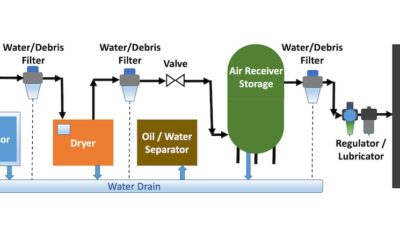HVLS Fans Cool in Summer, Distribute Heat in Winter

Without taking anything away from air conditioning, it is not the only option for comfort cooling. What’s more, it doesn’t do anything for your building during the heating season. An option that is receiving increasing attention is high-volume low-speed (HVLS) ceiling fans. These not only provide energy-efficient comfort cooling in the summer, but they can also improve the efficiency of your heating system in winter.
Comfort Level Up Dramatically
Don’t confuse these with the small ceiling paddle fans in your living room, kitchen or bedroom. These are BIG fans, with diameters up to 24 feet. They rotate slowly, but because of their size can move a lot of air. And air movement is the key to summer comfort for many spaces. By moving air over building occupants, evaporative cooling increases, improving comfort levels. According to some experts, the right HVLS system can reduce the perception of heat by 8 to 16 degrees.
Many commercial and industrial building have high ceilings and require higher overhead clearances. You need a big fan to move the necessary volume of air to give effective cooling. That’s why HVLS fans have large diameters and because of their blade length, can operate efficiently at relatively low rotational speeds.
Units Designed for Large Spaces
One of the industry leaders in HVLS fans is the humorously-named Big Ass Fan Co. of Lexington, Kentucky. The company offers its Powerfoil X line of fans for the industrial building market in sizes ranging from 8 to 24 feet. These fans feature a sealed and nitrogen-bathed gear reduction drive, with prewired on-board electronic controls. The design of the ten airfoil blades maximizes efficient air movement and minimizes acoustic levels to nearly undetectable levels. A winglet at the tip of each blade eliminates efficiency-robbing vortex formation. Big Ass Fan Co. also offer its Isis line of smaller, lighter fans in diameters of eight or ten feet for ceilings as low as 12 feet as in smaller commercial and industrial areas.
According to company spokesperson Katie Hunt, increasing number of owners are discovering the benefits of HVLS fans. “Given the vast space within manufacuring and warehouse facilities, these fans help eliminate cold and hot spots often prevalent with small, high velocity fans. During the winter, the fans run at a much slower speed to turn the air over at least once per hour to destratify the space and keep the temperature even, which can significantly reduce heating bills. The slow speed also prevents occupants from feeling a chilly draft.”
Added Benefits in Heating Season
As Hunter notes, HVLS fans also bring comfort benefits during the heating season. In many cases the heat in these high spaces stratifies and it can be as much as 20 degrees F warmer at the ceiling than at the floor or working level. Worker comfort can be maintained by fans gently pressing the heat layer down. This results in much less heating energy needed and with less unnecessary thermostat cycling.
Big Ass Fans are available with a remote control wall panel. Hunter notes, “This allows users to turn the fans on and off, set parameters, program speeds and troubleshoot operations. An unlimited number of fans can operate off a singe keypad, simplifying operations.” Fans can be supported by SmartSense365, an intuitive interface engineered to maximize energy savings and assure comfort through year-round automated control of each fan.
Benefits Beyond Comfort
HVLS fans are most often installed to improve summer and winter comfort in industrial and commercial spaces, but they can provide other benefits as well. According to Big Ass Fan Co., a recent Garland, Texas installation was designed to help eliminate damage to rolled steel products which resulted from condensate that forms on concrete floors and on the products during periods of high humidity and temperature changes. To the delight of the customer, the four 24-foot fans were completely effective in eliminating the condensation problem, saving the company $250,000 in product damage expense.
Maintenance expense for an HVLS fan system is minimal. According to Hunter, they do recommend an annual servicing of fans, including inspection of all safety cables, mounting bolts, fan controller connections, blade retainers and hub safety clips, along with a dusting of the motors, motor housings and airfoils.
Blade Mimics Whale Fin
Another manufacturer, Envira-North of Seaforth, Ontario, offers an industrial HVLS fan model called Altra-Air that features a blade design developed in collaboration with WhalePower Corp. The blade uses Tubercle Technology or “ripples” along the leading edge of the blades that mimic the fins of humpback whales. Research has shown that this approach allows the blade to have stall angles as high as 31 degrees. This improves blade efficiency and further reduces the acoustic signature.
Envira-North’s five-bladed Altra-Air fan is available in sizes from 2.4 to 7.3 m (8 to 24 ft.). The company suggests these fans are suitable for malls, atriums, auditoriums, barns, hockey rinks, gymnasiums, manufacturing facilities, warehouses, distribution centres, hangars, indoor paint ball arenas, pools, garages and lobbies. That represents a lot of air that needs to move.
Quiet Operation
Because of the low speed at which they operate and their sealed gearbox drives, HVLS fans are essentially very quiet, usually not being noticeable above other background noise. By placing the gearbox and motor near each other, electromagnetic interference (EMI) and radio frequency interference (RFI) are greatly reduced.
If your facility has large spaces with high ceilings, and if you would like to increase floor-level comfort and possibly even reduce heating expense in the winter, a HVLS fan system may be your best choice. You’ll need to determine ceiling height, potential mounting structures, type and amount of obstructions and the floor dimensions of the working area. By sharing this information with a manufacturer, they can determine the size and number of fans required for your facility to optimize comfort. You might be on the way to a changed indoor atmosphere.
More Info. >>>
Big Ass Fan Company
Envira-North Systems Ltd.
Macroair Technologies
www.macro-air.com



